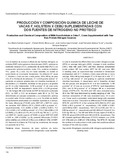| dc.rights.license | http://creativecommons.org/licenses/by-nc-sa/3.0/ve/ | |
| dc.contributor.author | Herrera Angulo, Ana María | |
| dc.contributor.author | Mora Luna, Robert Emilio | |
| dc.contributor.author | Isea Chávez, Juan Carlos | |
| dc.contributor.author | Eslava Tovar, José Fernando | |
| dc.contributor.author | Darghan, Aquiles Enrique | |
| dc.date.accessioned | 2017-06-09T18:50:59Z | |
| dc.date.available | 2017-06-09T18:50:59Z | |
| dc.date.issued | 2017-03 | |
| dc.identifier.issn | 0798-2259 | |
| dc.identifier.uri | http://www.saber.ula.ve/handle/123456789/43499 | |
| dc.description.abstract | Con el objetivo de evaluar el efecto de dos fuentes nitrógeno no proteico (NNP) sobre ganancia diaria de peso (GDP), cambios en condición corporal (CCC), producción de leche total (PLT) y su composición química (proteína cruda: PCL, proteína verdadera: PVL, grasa: GL y urea: UL) en vacas lactantes, se realizó un experimento en el suroeste Venezolano. Se utilizaron 31 vacas F1 Holstein x Cebú con dos o más partos, 419 ± 46 kg de peso vivo, 51 ± 18 días (d) de lactancia, 17,1 ± 3,3 kg leche·animal-1·d-1 pastando en potreros establecidos con Urochloa humidicola, U. decumbens y U. brizantha, divididas en dos grupos y asignados por 91 d a dos tratamientos: 1) 59 g·animal-1·d-1 de urea como fuente de NNP de degradación rápida (DR); y 2) 64 g·animal-1·d-1 de Optigen II® como fuente de NNP de liberación controlada (DC). La GDP y CCC se evaluaron cada 28 d. La PLT fue determinada por pesajes semanales y su composición química se evaluó cada 14 d en ordeños a.m. y p.m. Se utilizó un diseño completamente aleatorizado con medidas repetidas en el tiempo. No hubo diferencias (P>0,05) entre NNP-DR y NNP-DC sobre las variables GDP (504,4 ± 97,5 y 524,9 ± 90,3 g·animal-1·d-1, respectivamente), CCC (0,002 ± 0,001 y 0,004 ± 0,001), PLT (15,2 ± 0,62 y 14,7 ± 0,60 kg·animal-1·d-1), PVL (1,98 ± 0,09 y 2,10 ± 0,09%) y UL (40,9 ± 0,74 y 41,2 ± 0,79 mg·100 mL-1). La PCL con NNP-DC resultó superior (P<0,05) al grupo NNP-DR (3,05 ± 0,03 vs. 2,95 ± 0,03%). La GL presentó diferencias (P<0,01) entre ordeños a.m. (3,62 ± 0,12%) y p.m. (3,96 ± 0,12%). El NNP-DC favoreció la síntesis de PCL bajo las condiciones del ensayo sin aumento de la PVL. | es_VE |
| dc.language.iso | es | es_VE |
| dc.publisher | SABER-ULA | es_VE |
| dc.rights | info:eu-repo/semantics/openAccess | |
| dc.subject | Ganancia de peso | es_VE |
| dc.subject | Química en leche | es_VE |
| dc.subject | Suplementación nitrogenada | es_VE |
| dc.subject | Vacas lactantes | es_VE |
| dc.title | Producción y composición química de leche de vacas F1 Holstein X Cebú suplementadas con dos fuentes de nitrógeno no proteico | es_VE |
| dc.title.alternative | Production and Chemical Composition of Milk from Holstein x Zebu F1 Cows Supplemented with Two Non-Protein Nitrogen Sources | es_VE |
| dc.type | info:eu-repo/semantics/article | |
| dc.description.abstract1 | In order to evaluate the effect of two non-protein nitrogen sources (NPN) on average daily gain (ADG), changes in body condition (CBC), total milk yield (TMY) and their chemical composition (crude protein: MP, true protein: MTP, fat: MF, and urea: MU) in lactating cows, an experiment was conducted in Venezuelan southwestern with 31 F1 Holstein x Zebu cows with two or more calvings, 419 ± 46 kg body weight, 51 ± 18 days (d) in milk, 17.1 ± 3.3 kg milk·animal-1·d-1 and grazing on pastures established Urochloa humidicola, U. decumbens and U. brizantha, divided into two groups and assigned for 91 d to two treatments: 1) 59 g·animal-1·d-1 of urea as a source of NPN for rapid degradation (RD), and 2) 64 g·animal-1·d-1 of Optigen II® as a controlled release of NPN (CR). The ADG and CBC were evaluated every 28 d; the TMY was determined by weekly weighing of milk. The chemical composition of milk was evaluated every 14 d a.m./p.m. It was used a completely randomized design with repeated measures over time. There were no differences (P>0.05) between NPN-RD and NPN-CR in the variables ADG (504.4 ± 97.5 and 524.9 ± 90.3 g·animal-1·d-1, respectively), CBC (0.002 ± 0.001 and 0.004 ± 0.001, respectively), TMY (15.2 ± 0.62 and 14.7 ± 0.60 kg·animal-1·d-1, respectively) and MU (40.9 ± 0.74 and 41.2 ± 0.79 mg·100 mL-1). The MP with NPN-CR was higher (P<0.05) to NPN-RD group (3.05 ± 0.03 and 2.95 ± 0.03 %, respectively). The MF showed significant differences (P<0.01) between a.m. (3.62 ± 0.12%) and p.m. (3.96 ± 0.12%) milking. The NPN-CR, favored the synthesis of crude protein in milk under test conditions without increase of the milk true protein. | es_VE |
| dc.description.colacion | 119-130 | es_VE |
| dc.description.email | anamariaherreraangulo@yahoo.com | es_VE |
| dc.description.email | robertmora78@gmail.com | es_VE |
| dc.identifier.depositolegal | pp199102ZU46 | |
| dc.identifier.edepositolegal | ppi201502ZU4665 | |
| dc.identifier.eissn | 2477-944X | |
| dc.publisher.pais | Venezuela | es_VE |
| dc.subject.institucion | Universidad del Zulia (LUZ) | es_VE |
| dc.subject.institucion | Universidad de Los Andes (ULA) | es_VE |
| dc.subject.keywords | Weight gain | es_VE |
| dc.subject.keywords | Chemistry milk | es_VE |
| dc.subject.keywords | Nitrogen supplementation | es_VE |
| dc.subject.keywords | Lactating cows | es_VE |
| dc.subject.publicacionelectronica | Revista Científica | |
| dc.subject.seccion | Revista Científica: Producción Animal | es_VE |
| dc.subject.thematiccategory | Medio Ambiente | es_VE |
| dc.subject.tipo | Revistas | es_VE |
| dc.type.media | Texto | es_VE |


